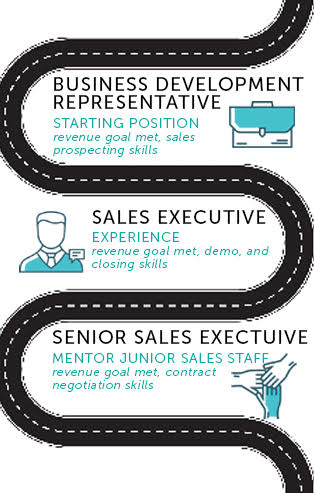By Christian Valiulis
Have you finally hired that dream candidate? If so, how does your organization plan on retaining these high-performing employees along with the rest of your workforce? Once you’ve filled those open positions, there’s still work to be done to keep your employees from leaving your organization for greener pastures.
What if there was a way to decrease your company’s employee turnover rate while increasing employee productivity and engagement? In this article, we’ll discuss the up-and-coming trend of career pathing and the three main reasons why your company needs this tactic in your HR arsenal. We’ll also cover how you can implement this career development tool with the resources you’re already utilizing.
What is Career Pathing?
Career pathing is an employee development tool used to help individuals chart out their professional journey in an organization. Not to be confused with a succession plan, a career path is a personalized plan, rather than a standardized process for all employees. Employers can offer this tool to help current and new hires develop a career plan that breaks down the steps needed to reach their goals. These career steps can include specialized skills, positions, training, required revenue goals or quotas, additional education, and required experience.
Below is an example of a basic career path for an individual starting their career as an entry-level salesperson and working their way to a senior sales position:

The Current Climate of HR
Employee retention must be a top priority for employers or there’s a risk of losing valuable, high-performing workers. Now that the millennial workforce has gained experience, they are no longer working entry-level positions and are searching for advancements. While older generations have a tendency to stay at the same company, earn promotions, and then retire, today’s trend is focused on open conversations about career objectives. Sixty percent of HR professionals think they’re giving their staff a clear career path, but only 36 percent of employees agree with that statement. The gap in agreeance shows a disconnect between what HR leaders believe employees are looking for in a company career and what is actually being offered.
Why Now is the Time to Implement Career Pathing
It’s no longer in the best interest of employers to operate with a “what can this employee do for my company” mindset. Instead, they must start thinking about what the company can do for the individual, especially for employees under 30 in the workforce. Managers need to have open conversations with candidates and staff about what they want to accomplish, as well as how they are going to achieve those goals during their employment. Through these conversations, career development and performance expectations can be set with the best interests of both parties in mind. These types of transparent discussions will also help boost employee morale, decrease turnover, and help create a healthier bottom line.
Implementing career pathing is crucial if you want to keep your most valuable workforce employed for more than just a few years. With this proactive approach, you’ll increase employee retention, productivity, and engagement.
1. Employee Retention
In the days of low unemployment rates and the rise of new workforce generations, employers are not only having trouble recruiting talent but keeping those employees long-term. In 2016, millennials became the largest generation in the workforce and businesses are seeing the effects of their presence with a huge emphasis on the employee experience. So it comes as no surprise that one of the common reasons employees leave their current role is due to lacking career training and career growth opportunities.
Only 7 percent of employees take positions within their current organizations to advance their careers, which speaks to a majority of companies’ employee experiences. If your employees don’t see the potential for professional growth in your organization, they’ll look for a new opportunity whether that’s the gig economy, another company, or a competitor that offers an exceptional employee experience including career development, mentorship programs, and training tools. By providing these aspects of the employee journey, your workforce has an opportunity to thrive and learn. This benefits the individual employee and your organization. Employees are much more likely to be loyal to their employer if they know career development tools and opportunities are available.
Offering training and progression tools like career pathing can deter 86 percent of millennials from leaving their current position. It’s a no-brainer for developing your retention strategy to keep your largest workforce generation and top talent in your company.
2. Employee Productivity
If you could only work in your current role for the rest of your career with no advancement, would your productivity decrease or increase? It’s the question companies must ask themselves as many of their employees ponder this thought while completing the same work day in and day out. Employees are more likely to come to work excited about honing their current skills and learning new ones to help them reach their professional goals. When there are no growth opportunities available, employees become stagnant, diminishing productivity and quality of work.
Having a career plan for individuals gives them the motivation to work hard and reach each step in their ultimate career goal. The different career steps ensure the individual is learning new skills, completing various projects, and acquiring valuable experience. Not all employees who start out in the same role or department want the same promotions or have the same ambitions, so it’s crucial to personalize career maps for individuals and work towards a goal important to them.
3. Employee Engagement
Employee engagement. A popular buzzword among those in the HR community, and an important one at that. Companies with poor employee engagement often see unsatisfied workers who don’t see their future with the organization or feel their company isn’t investing in them. They quickly become disengaged in their work, disconnect from other team members, and then eventually move on to their next job. By providing career advancement tools to help achieve their career objectives, employees are more willing to stay loyal to a company that invests in their growth.
Almost ninety percent of employees who are engaged are less likely to leave their jobs, so it’s imperative to implement career pathing into the employee experience. Professional development is an inexpensive opportunity to boost employee engagement by showing employees your commitment to their growth and success with the company. Individuals can work one-on-one with their manager to develop their career map in the organization. As a manager, you’ll have the ability to provide transparent, supportive coaching for individuals as they work toward their career aspirations. An engaging employee experience is one that includes a variety of opportunities along with the managerial guidance to choose the right path.
Start Retaining Loyal, High-Performing Employees
It’s time to get serious about employee retention, productivity, and engagement at your company. You can’t afford to lose quality employees, and if they’re unsatisfied in their current position they may already be looking for greener pastures. Not sure where to start? Begin by developing career paths with a select group of employees and see what results come from those working toward their ultimate goal. After a few test runs, you can mold the career pathing experience to best meet the needs of your employees and organization. Whether you offer professional advancement to boost retention rates, productivity, engagement, or all of the above, you’re giving your employees the opportunity to take ownership of their career with organizational support.

Chief Revenue Officer
APS Payroll
cvaliulis@apspayroll.com
www.apspayroll.com
